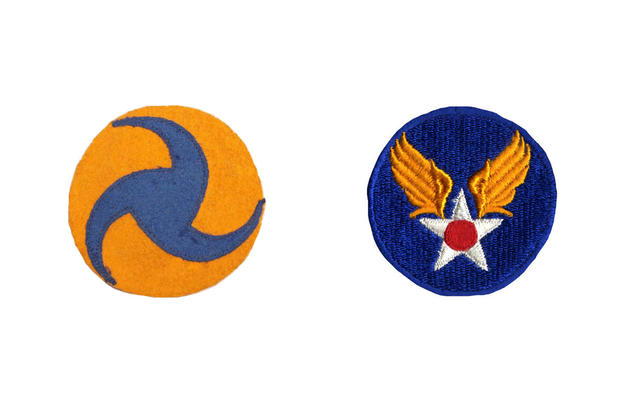U.S. military aviation was born under the U.S. Army Signal Corps, which explains why the first fliers' insignia featured wings superimposed on signal flags. The fledgling Air Service racked up an impressive combat record in World War I, firmly establishing its independent identity and paving the way for the famous winged propeller insignia. Adopted in 1918, this became the longest-lived element in Air Force heraldry.
The Army Air Corps wore the wings-and-props through World War II, and the symbol survives today upon the uniforms of Air Force Academy cadets and Air Force band members. (The Army's Aviation Branch reinstated the winged prop as its insignia in the 1980s, a somewhat confusing tribute to its past.)
Shoulder insignia have varied even more often. At the end of WWI, many Air Service units created shoulder patches from the roundel painted on aircraft wings. These roundels were often combined with their larger unit, as in the First Army patch shown at right. Most Army Air Corps units went without shoulder patches until 1937, when the service issued a blue whirling propeller on an orange disc. This somewhat psychedelic image was replaced in 1941 by Gen. Hap Arnold's now-famous winged star.
The newly independent Air Force dropped shoulder patches in 1947, but Arnold's design showed up for years on flight jackets, helmets and elsewhere. It remains closely associated with the Air Force's achievements in WWII and Korea, and indeed is more commonly recognized than the winged prop or the USAF coat of arms adopted in 1947.
Traditionalists can take comfort that the Air Force's slick new logo recalls this traditional design, albeit with some angular crumpling. And the Air Force isn't the only service to change insignia now and again. For example, the Marines didn't adopt their famous eagle, globe and anchor until '68. But that was 1868. Our guess is that the Air Force won't wait that long before another overhaul.
Want to Know More About the Military?
Be sure to get the latest news about the U.S. military, as well as critical info about how to join and all the benefits of service. Subscribe to Military.com and receive customized updates delivered straight to your inbox.















